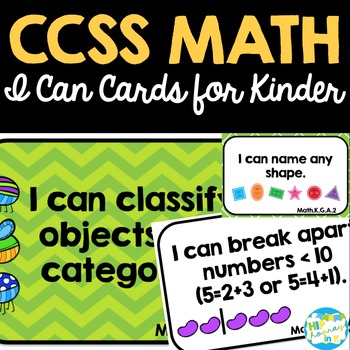CCSS I Can Cards for Kinder Math
Hip Hooray in K - Kirstin McGinnis
1.4k Followers
Grade Levels
PreK - 1st, Homeschool, Staff
Subjects
Resource Type
Standards
CCSSK.CC.A.1
CCSSK.MD.A.2
CCSSK.NBT.A.1
CCSSK.OA.A.3
CCSSK.G.B.4
Formats Included
- PDF
Pages
30 pages
Hip Hooray in K - Kirstin McGinnis
1.4k Followers
Description
Common Core Kindergarten Math cards that break down the standards into "I Can" statements.
Useful ideas:
-post in your room as objectives
-put on a binder ring for each planning alignment
-display on projects posted in the hallway.
You may also be interested in these resources:
Danielson Documentation Digital Portfolio
March Lions and Lambs
Qr Addition and Subtraction
Editable Templates for Center Games
QR Sight Word Scramble
Welcome to K EDITABLE Bundle
Welcome to K EDITABLE SPANISH
Sight Word Practice Pages
QR GROWING Bundle
Welcome to K ENGLISH
For more great ideas, follow me:
Blog Hip Hooray in K: Primary & TECH Blog
Instagram Hip Hooray in KFacebook Hip Hooray in KTwitter Hip Hooray in KGet credit for future purchases!
Log in & Go to "My Purchases"
Next to each purchase you'll see a "Provide Feedback" button.
Click & give short feedback
I highly value your feedback! It helps me create and edit products to suit you better!
Become a follower!
Be the first to know about my new discounts, freebies, and product launches. Look for the red star near the top of any page within my store and click it to become a follower.
Useful ideas:
-post in your room as objectives
-put on a binder ring for each planning alignment
-display on projects posted in the hallway.
You may also be interested in these resources:
Danielson Documentation Digital Portfolio
March Lions and Lambs
Qr Addition and Subtraction
Editable Templates for Center Games
QR Sight Word Scramble
Welcome to K EDITABLE Bundle
Welcome to K EDITABLE SPANISH
Sight Word Practice Pages
QR GROWING Bundle
Welcome to K ENGLISH
For more great ideas, follow me:
Blog Hip Hooray in K: Primary & TECH Blog
Instagram Hip Hooray in KFacebook Hip Hooray in KTwitter Hip Hooray in KGet credit for future purchases!
Log in & Go to "My Purchases"
Next to each purchase you'll see a "Provide Feedback" button.
Click & give short feedback
I highly value your feedback! It helps me create and edit products to suit you better!
Become a follower!
Be the first to know about my new discounts, freebies, and product launches. Look for the red star near the top of any page within my store and click it to become a follower.
Total Pages
30 pages
Answer Key
N/A
Teaching Duration
N/A
Last updated Aug 21st, 2013
Report this resource to TPT
Reported resources will be reviewed by our team. Report this resource to let us know if this resource violates TPT’s content guidelines.
Standards
to see state-specific standards (only available in the US).
CCSSK.CC.A.1
Count to 100 by ones and by tens.
CCSSK.MD.A.2
Directly compare two objects with a measurable attribute in common, to see which object has “more of”/“less of” the attribute, and describe the difference. For example, directly compare the heights of two children and describe one child as taller/shorter.
CCSSK.NBT.A.1
Compose and decompose numbers from 11 to 19 into ten ones and some further ones, e.g., by using objects or drawings, and record each composition or decomposition by a drawing or equation (e.g., 18 = 10 + 8); understand that these numbers are composed of ten ones and one, two, three, four, five, six, seven, eight, or nine ones.
CCSSK.OA.A.3
Decompose numbers less than or equal to 10 into pairs in more than one way, e.g., by using objects or drawings, and record each decomposition by a drawing or equation (e.g., 5 = 2 + 3 and 5 = 4 + 1).
CCSSK.G.B.4
Analyze and compare two- and three-dimensional shapes, in different sizes and orientations, using informal language to describe their similarities, differences, parts (e.g., number of sides and vertices/“corners”) and other attributes (e.g., having sides of equal length).





